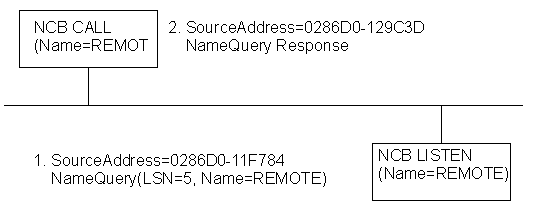
The 254-session limit is based on a key variable in the NetBIOS architecture called the Local Session Number (LSN). This is a one-byte number (0 to 255) with several numbers reserved for system use. When two computers establish a session via NBF, there is an exchange of LSNs.
The LSNs on the two computers might be different. They do not have to match, but a computer always uses the same LSN for a given session. This number is assigned when a program issues a CALL NCB (Network Control Block). The number is actually shared between the two computers in the initial frame sent from the calling computer to the listening computer. Figure 6.4 shows this session-creation frame exchange.

Figure 6.4 Broadcast of NameQuery
The initial frame is a NameQuery frame. In previous implementations of NBF, this frame was broadcast onto the network. All computers read the frame and check to see if they have the name in their name space and if there is a LISTEN NCB pending on the name. If there is a LISTEN NCB pending, the computer assigns a new LSN for itself, and then adds it to the response frame and satisfies the LISTEN NCB, which now contains just the LSN used on that computer. Even though both computers know the LSN of the other, the information is not used. The more important information for the two communicating partners is the network addresses that are part of the frames. As the frames are exchanged, each partner picks up the address of the other in the source address component of the frame received. The NBF protocol keeps the network address of the remote partner so that subsequent frames can be addressed directly.
Note This process applies for NBF connections. NetBIOS connections established via TCP/IP and RFC1001/1002 or NBP are handled differently.
Windows NT has to use the same NameQuery frame to establish connections with remote computers via NBF; otherwise, it would not be able to talk to existing workstations and servers. The NameQuery frame transmitted must contain the 1-byte-wide LSN to be used.